Case Study: Mrs. Clark - HDU Assessment 1 - Cardiac and Respiratory
VerifiedAdded on 2022/08/13
|13
|2816
|268
Case Study
AI Summary
This case study centers on Mrs. Clark, an 83-year-old woman admitted to the HDU following a partial gastrectomy due to cardiac arrhythmia (CA) with a history of COPD. The assessment begins with an interpretation of her ECG, revealing ventricular tachycardia (VT) characterized by an irregular cardiac rate. The case explores potential causes of VT, including COPD, age, and recent surgery, alongside treatment options such as radiofrequency ablation, implantable cardioverter defibrillator, and medications. Furthermore, the study delves into Mrs. Clark's respiratory condition, focusing on her arterial blood gas (ABG) analysis, which indicates respiratory acidosis and hypoxemia. The pathophysiology of COPD, including hypersecretion of mucus and airflow obstruction, is discussed, along with medical and nursing interventions aimed at improving airway clearance and gas exchange. The assignment covers the systematic patient assessment using ECG, medical history, ABG analysis and physical examinations, including the ABCDE approach, and emphasizes the importance of documentation and monitoring in Mrs. Clark's care.

Running Head: Case Study-Mrs.Clark
Assessment 1
Case Study- Mrs Clark
Student Name:
Student ID:
Assessment 1
Case Study- Mrs Clark
Student Name:
Student ID:
Paraphrase This Document
Need a fresh take? Get an instant paraphrase of this document with our AI Paraphraser

Case Study- Mrs. Clark 2
Mrs Clark is 83 year old women admitted in HDU for the last 2 days for partial
gastrectomy for Cardiac Arrhythmia (CA). She has a history of COPD.
1. Cardiac Arrhythmia
The Cardiac Rhythm of Mrs. Clark shows Ventricular Tachycardia (VT) with left
bundle morphology and irregular cardiac rate of nearly 110 beats per minute.
Ventricular Tachycardia is a kind of cardiac arrhythmia with abnormal QRS complex
originating in the ventricle at a faster rate of more than 110 breaths per Minute. ECG
of Clark shows negative QRS complex. The R wave is changing from narrow to wide
after 5 normal QRS waves, intermittently. P wave disappears during the 5-6 waves
of negative QRS phase. The ECG shows 5 negative or abnormal heart beats in a
row, after that the normal heart beats resume back. PR interval is normal which
shows, normally slow conduction through atrio-ventricular node. The delay makes
the atria to fill up the ventricles prior to commencement of ventricular contraction.
The QRS complex in the V2 phase, or deformed part of the ECG shows a large
negative Q wave which is followed by a small positive r wave.
The increase in general automaticity initiated by late or early after depolarisations
and the re-entry activity results into ventricular tachycardia. The cardiac muscles in
deflected area are taking more time to repolarise which may be due to damaged
cardiac tissue or disturbance in electrical conduction or injured myocardial infarction.
In the middle part of the ECG strip, the changes due to intermittent ventricular
repolarisation are masked by the secondary T waves generated by disturbance in
Mrs Clark is 83 year old women admitted in HDU for the last 2 days for partial
gastrectomy for Cardiac Arrhythmia (CA). She has a history of COPD.
1. Cardiac Arrhythmia
The Cardiac Rhythm of Mrs. Clark shows Ventricular Tachycardia (VT) with left
bundle morphology and irregular cardiac rate of nearly 110 beats per minute.
Ventricular Tachycardia is a kind of cardiac arrhythmia with abnormal QRS complex
originating in the ventricle at a faster rate of more than 110 breaths per Minute. ECG
of Clark shows negative QRS complex. The R wave is changing from narrow to wide
after 5 normal QRS waves, intermittently. P wave disappears during the 5-6 waves
of negative QRS phase. The ECG shows 5 negative or abnormal heart beats in a
row, after that the normal heart beats resume back. PR interval is normal which
shows, normally slow conduction through atrio-ventricular node. The delay makes
the atria to fill up the ventricles prior to commencement of ventricular contraction.
The QRS complex in the V2 phase, or deformed part of the ECG shows a large
negative Q wave which is followed by a small positive r wave.
The increase in general automaticity initiated by late or early after depolarisations
and the re-entry activity results into ventricular tachycardia. The cardiac muscles in
deflected area are taking more time to repolarise which may be due to damaged
cardiac tissue or disturbance in electrical conduction or injured myocardial infarction.
In the middle part of the ECG strip, the changes due to intermittent ventricular
repolarisation are masked by the secondary T waves generated by disturbance in
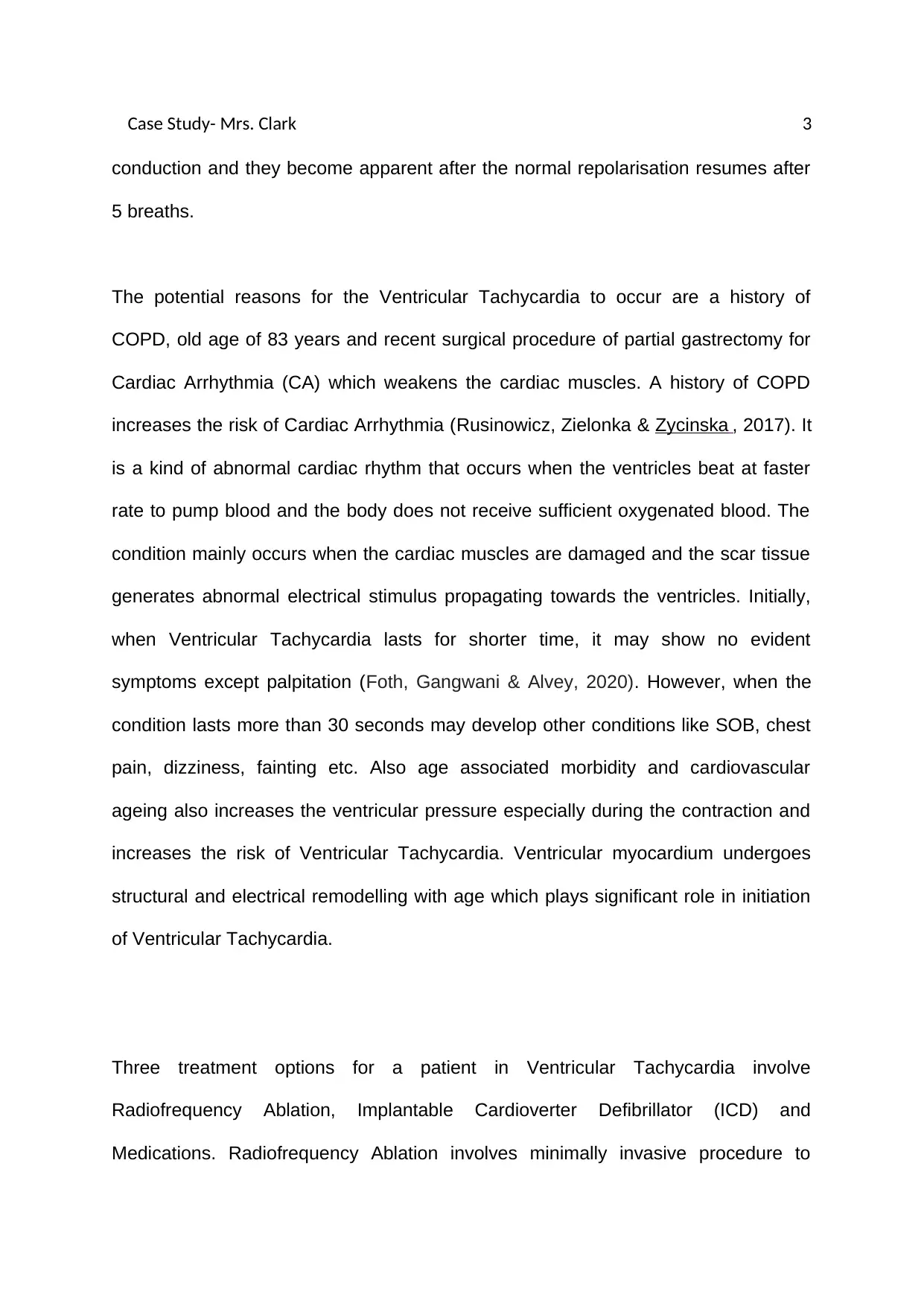
Case Study- Mrs. Clark 3
conduction and they become apparent after the normal repolarisation resumes after
5 breaths.
The potential reasons for the Ventricular Tachycardia to occur are a history of
COPD, old age of 83 years and recent surgical procedure of partial gastrectomy for
Cardiac Arrhythmia (CA) which weakens the cardiac muscles. A history of COPD
increases the risk of Cardiac Arrhythmia (Rusinowicz, Zielonka & Zycinska , 2017). It
is a kind of abnormal cardiac rhythm that occurs when the ventricles beat at faster
rate to pump blood and the body does not receive sufficient oxygenated blood. The
condition mainly occurs when the cardiac muscles are damaged and the scar tissue
generates abnormal electrical stimulus propagating towards the ventricles. Initially,
when Ventricular Tachycardia lasts for shorter time, it may show no evident
symptoms except palpitation (Foth, Gangwani & Alvey, 2020). However, when the
condition lasts more than 30 seconds may develop other conditions like SOB, chest
pain, dizziness, fainting etc. Also age associated morbidity and cardiovascular
ageing also increases the ventricular pressure especially during the contraction and
increases the risk of Ventricular Tachycardia. Ventricular myocardium undergoes
structural and electrical remodelling with age which plays significant role in initiation
of Ventricular Tachycardia.
Three treatment options for a patient in Ventricular Tachycardia involve
Radiofrequency Ablation, Implantable Cardioverter Defibrillator (ICD) and
Medications. Radiofrequency Ablation involves minimally invasive procedure to
conduction and they become apparent after the normal repolarisation resumes after
5 breaths.
The potential reasons for the Ventricular Tachycardia to occur are a history of
COPD, old age of 83 years and recent surgical procedure of partial gastrectomy for
Cardiac Arrhythmia (CA) which weakens the cardiac muscles. A history of COPD
increases the risk of Cardiac Arrhythmia (Rusinowicz, Zielonka & Zycinska , 2017). It
is a kind of abnormal cardiac rhythm that occurs when the ventricles beat at faster
rate to pump blood and the body does not receive sufficient oxygenated blood. The
condition mainly occurs when the cardiac muscles are damaged and the scar tissue
generates abnormal electrical stimulus propagating towards the ventricles. Initially,
when Ventricular Tachycardia lasts for shorter time, it may show no evident
symptoms except palpitation (Foth, Gangwani & Alvey, 2020). However, when the
condition lasts more than 30 seconds may develop other conditions like SOB, chest
pain, dizziness, fainting etc. Also age associated morbidity and cardiovascular
ageing also increases the ventricular pressure especially during the contraction and
increases the risk of Ventricular Tachycardia. Ventricular myocardium undergoes
structural and electrical remodelling with age which plays significant role in initiation
of Ventricular Tachycardia.
Three treatment options for a patient in Ventricular Tachycardia involve
Radiofrequency Ablation, Implantable Cardioverter Defibrillator (ICD) and
Medications. Radiofrequency Ablation involves minimally invasive procedure to
⊘ This is a preview!⊘
Do you want full access?
Subscribe today to unlock all pages.

Trusted by 1+ million students worldwide

Case Study- Mrs. Clark 4
damage the cells which develop ventricular tachycardia (Dukkipati, Choudry, Koruth
& Miller, 2017). The procedure is less effective when the patient has a history of
structural cardiac illness. Implantable Cardioverter Defibrillator involves a procedure
to implant a device which provides electrical impulse to the cardiac muscles for
resetting the irregular or abnormal heart beat. The device continuously monitors the
heart beat, detects any abnormal heart rate, and delivers precise electric shocks for
restoring normal cardiac rhythm. Multiple antiarrhythmic medicines can be
administered to the patient for curing the VT (Chiale, Etcheverry & Pastori, 2014).
The medications include Amiodarone, Propafenone, Flecainide and Sotolol etc.
COPD and VT are independently associated (Konecny, 2018). The patients of
COPD are at high risk of mortality due to VT. In emergency conditions, electrical
defibrillation, CPR and IV medicines may also be given to reduce the heart rate.
Overall the management and treatment of Tachycardia involves managing and
controlling any health condition that causes abnormal heart rhythm.
2. Pathophysiology and treatment
Arterial Blood Gases is performed to assess the severity of patient’s health
condition, oxygen delivery and acid base balance. The assessment results help in
damage the cells which develop ventricular tachycardia (Dukkipati, Choudry, Koruth
& Miller, 2017). The procedure is less effective when the patient has a history of
structural cardiac illness. Implantable Cardioverter Defibrillator involves a procedure
to implant a device which provides electrical impulse to the cardiac muscles for
resetting the irregular or abnormal heart beat. The device continuously monitors the
heart beat, detects any abnormal heart rate, and delivers precise electric shocks for
restoring normal cardiac rhythm. Multiple antiarrhythmic medicines can be
administered to the patient for curing the VT (Chiale, Etcheverry & Pastori, 2014).
The medications include Amiodarone, Propafenone, Flecainide and Sotolol etc.
COPD and VT are independently associated (Konecny, 2018). The patients of
COPD are at high risk of mortality due to VT. In emergency conditions, electrical
defibrillation, CPR and IV medicines may also be given to reduce the heart rate.
Overall the management and treatment of Tachycardia involves managing and
controlling any health condition that causes abnormal heart rhythm.
2. Pathophysiology and treatment
Arterial Blood Gases is performed to assess the severity of patient’s health
condition, oxygen delivery and acid base balance. The assessment results help in
Paraphrase This Document
Need a fresh take? Get an instant paraphrase of this document with our AI Paraphraser
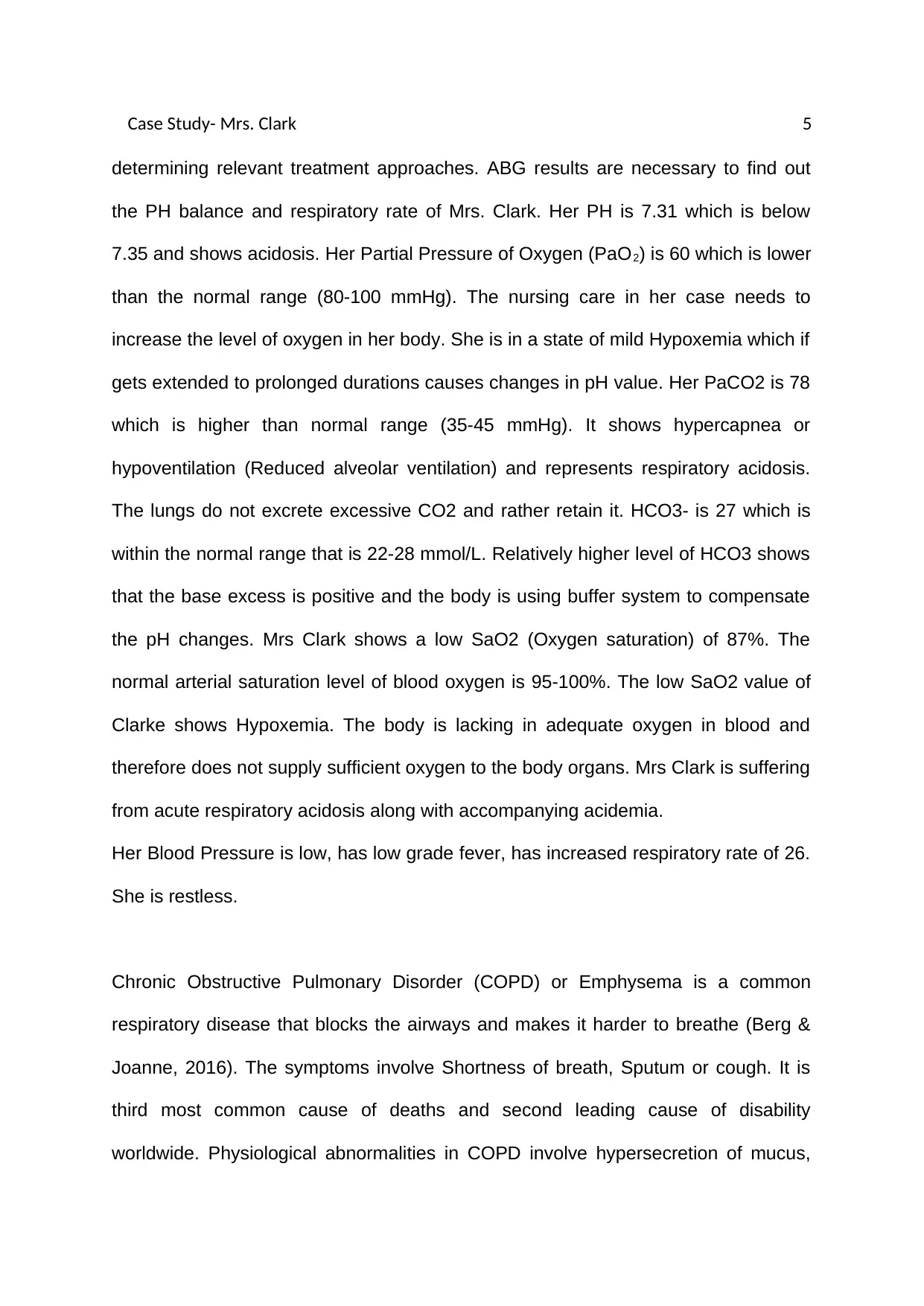
Case Study- Mrs. Clark 5
determining relevant treatment approaches. ABG results are necessary to find out
the PH balance and respiratory rate of Mrs. Clark. Her PH is 7.31 which is below
7.35 and shows acidosis. Her Partial Pressure of Oxygen (PaO2) is 60 which is lower
than the normal range (80-100 mmHg). The nursing care in her case needs to
increase the level of oxygen in her body. She is in a state of mild Hypoxemia which if
gets extended to prolonged durations causes changes in pH value. Her PaCO2 is 78
which is higher than normal range (35-45 mmHg). It shows hypercapnea or
hypoventilation (Reduced alveolar ventilation) and represents respiratory acidosis.
The lungs do not excrete excessive CO2 and rather retain it. HCO3- is 27 which is
within the normal range that is 22-28 mmol/L. Relatively higher level of HCO3 shows
that the base excess is positive and the body is using buffer system to compensate
the pH changes. Mrs Clark shows a low SaO2 (Oxygen saturation) of 87%. The
normal arterial saturation level of blood oxygen is 95-100%. The low SaO2 value of
Clarke shows Hypoxemia. The body is lacking in adequate oxygen in blood and
therefore does not supply sufficient oxygen to the body organs. Mrs Clark is suffering
from acute respiratory acidosis along with accompanying acidemia.
Her Blood Pressure is low, has low grade fever, has increased respiratory rate of 26.
She is restless.
Chronic Obstructive Pulmonary Disorder (COPD) or Emphysema is a common
respiratory disease that blocks the airways and makes it harder to breathe (Berg &
Joanne, 2016). The symptoms involve Shortness of breath, Sputum or cough. It is
third most common cause of deaths and second leading cause of disability
worldwide. Physiological abnormalities in COPD involve hypersecretion of mucus,
determining relevant treatment approaches. ABG results are necessary to find out
the PH balance and respiratory rate of Mrs. Clark. Her PH is 7.31 which is below
7.35 and shows acidosis. Her Partial Pressure of Oxygen (PaO2) is 60 which is lower
than the normal range (80-100 mmHg). The nursing care in her case needs to
increase the level of oxygen in her body. She is in a state of mild Hypoxemia which if
gets extended to prolonged durations causes changes in pH value. Her PaCO2 is 78
which is higher than normal range (35-45 mmHg). It shows hypercapnea or
hypoventilation (Reduced alveolar ventilation) and represents respiratory acidosis.
The lungs do not excrete excessive CO2 and rather retain it. HCO3- is 27 which is
within the normal range that is 22-28 mmol/L. Relatively higher level of HCO3 shows
that the base excess is positive and the body is using buffer system to compensate
the pH changes. Mrs Clark shows a low SaO2 (Oxygen saturation) of 87%. The
normal arterial saturation level of blood oxygen is 95-100%. The low SaO2 value of
Clarke shows Hypoxemia. The body is lacking in adequate oxygen in blood and
therefore does not supply sufficient oxygen to the body organs. Mrs Clark is suffering
from acute respiratory acidosis along with accompanying acidemia.
Her Blood Pressure is low, has low grade fever, has increased respiratory rate of 26.
She is restless.
Chronic Obstructive Pulmonary Disorder (COPD) or Emphysema is a common
respiratory disease that blocks the airways and makes it harder to breathe (Berg &
Joanne, 2016). The symptoms involve Shortness of breath, Sputum or cough. It is
third most common cause of deaths and second leading cause of disability
worldwide. Physiological abnormalities in COPD involve hypersecretion of mucus,
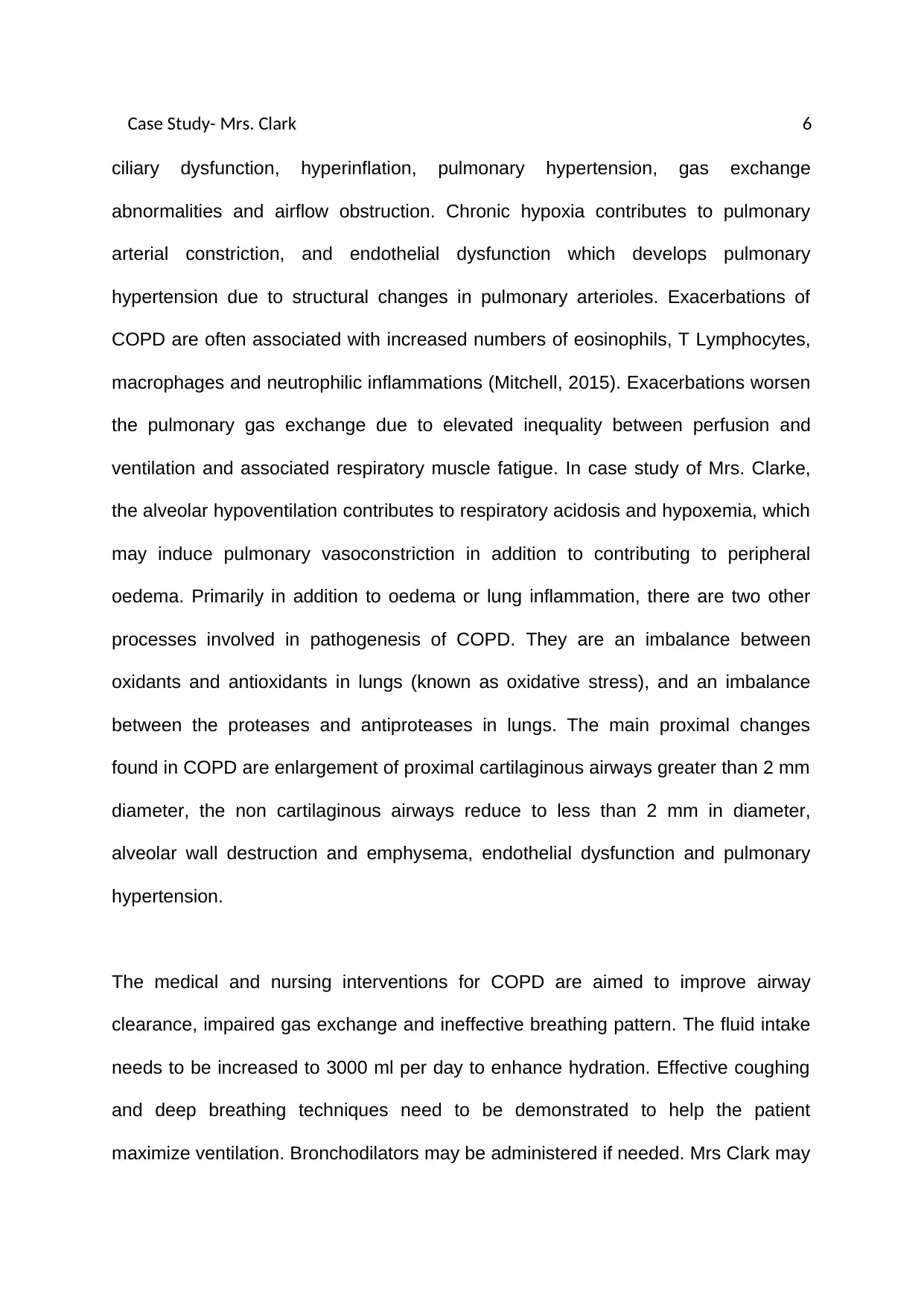
Case Study- Mrs. Clark 6
ciliary dysfunction, hyperinflation, pulmonary hypertension, gas exchange
abnormalities and airflow obstruction. Chronic hypoxia contributes to pulmonary
arterial constriction, and endothelial dysfunction which develops pulmonary
hypertension due to structural changes in pulmonary arterioles. Exacerbations of
COPD are often associated with increased numbers of eosinophils, T Lymphocytes,
macrophages and neutrophilic inflammations (Mitchell, 2015). Exacerbations worsen
the pulmonary gas exchange due to elevated inequality between perfusion and
ventilation and associated respiratory muscle fatigue. In case study of Mrs. Clarke,
the alveolar hypoventilation contributes to respiratory acidosis and hypoxemia, which
may induce pulmonary vasoconstriction in addition to contributing to peripheral
oedema. Primarily in addition to oedema or lung inflammation, there are two other
processes involved in pathogenesis of COPD. They are an imbalance between
oxidants and antioxidants in lungs (known as oxidative stress), and an imbalance
between the proteases and antiproteases in lungs. The main proximal changes
found in COPD are enlargement of proximal cartilaginous airways greater than 2 mm
diameter, the non cartilaginous airways reduce to less than 2 mm in diameter,
alveolar wall destruction and emphysema, endothelial dysfunction and pulmonary
hypertension.
The medical and nursing interventions for COPD are aimed to improve airway
clearance, impaired gas exchange and ineffective breathing pattern. The fluid intake
needs to be increased to 3000 ml per day to enhance hydration. Effective coughing
and deep breathing techniques need to be demonstrated to help the patient
maximize ventilation. Bronchodilators may be administered if needed. Mrs Clark may
ciliary dysfunction, hyperinflation, pulmonary hypertension, gas exchange
abnormalities and airflow obstruction. Chronic hypoxia contributes to pulmonary
arterial constriction, and endothelial dysfunction which develops pulmonary
hypertension due to structural changes in pulmonary arterioles. Exacerbations of
COPD are often associated with increased numbers of eosinophils, T Lymphocytes,
macrophages and neutrophilic inflammations (Mitchell, 2015). Exacerbations worsen
the pulmonary gas exchange due to elevated inequality between perfusion and
ventilation and associated respiratory muscle fatigue. In case study of Mrs. Clarke,
the alveolar hypoventilation contributes to respiratory acidosis and hypoxemia, which
may induce pulmonary vasoconstriction in addition to contributing to peripheral
oedema. Primarily in addition to oedema or lung inflammation, there are two other
processes involved in pathogenesis of COPD. They are an imbalance between
oxidants and antioxidants in lungs (known as oxidative stress), and an imbalance
between the proteases and antiproteases in lungs. The main proximal changes
found in COPD are enlargement of proximal cartilaginous airways greater than 2 mm
diameter, the non cartilaginous airways reduce to less than 2 mm in diameter,
alveolar wall destruction and emphysema, endothelial dysfunction and pulmonary
hypertension.
The medical and nursing interventions for COPD are aimed to improve airway
clearance, impaired gas exchange and ineffective breathing pattern. The fluid intake
needs to be increased to 3000 ml per day to enhance hydration. Effective coughing
and deep breathing techniques need to be demonstrated to help the patient
maximize ventilation. Bronchodilators may be administered if needed. Mrs Clark may
⊘ This is a preview!⊘
Do you want full access?
Subscribe today to unlock all pages.

Trusted by 1+ million students worldwide
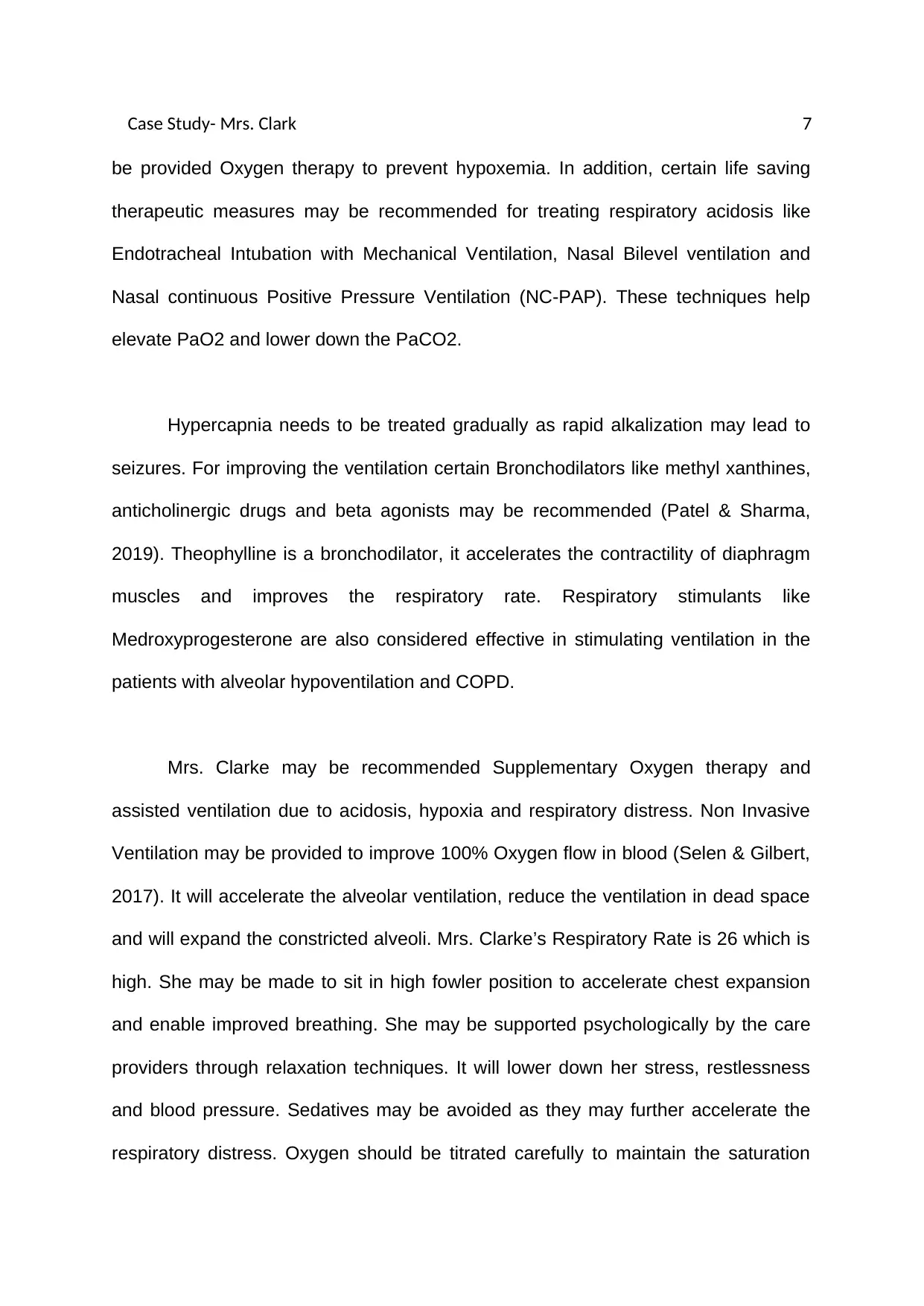
Case Study- Mrs. Clark 7
be provided Oxygen therapy to prevent hypoxemia. In addition, certain life saving
therapeutic measures may be recommended for treating respiratory acidosis like
Endotracheal Intubation with Mechanical Ventilation, Nasal Bilevel ventilation and
Nasal continuous Positive Pressure Ventilation (NC-PAP). These techniques help
elevate PaO2 and lower down the PaCO2.
Hypercapnia needs to be treated gradually as rapid alkalization may lead to
seizures. For improving the ventilation certain Bronchodilators like methyl xanthines,
anticholinergic drugs and beta agonists may be recommended (Patel & Sharma,
2019). Theophylline is a bronchodilator, it accelerates the contractility of diaphragm
muscles and improves the respiratory rate. Respiratory stimulants like
Medroxyprogesterone are also considered effective in stimulating ventilation in the
patients with alveolar hypoventilation and COPD.
Mrs. Clarke may be recommended Supplementary Oxygen therapy and
assisted ventilation due to acidosis, hypoxia and respiratory distress. Non Invasive
Ventilation may be provided to improve 100% Oxygen flow in blood (Selen & Gilbert,
2017). It will accelerate the alveolar ventilation, reduce the ventilation in dead space
and will expand the constricted alveoli. Mrs. Clarke’s Respiratory Rate is 26 which is
high. She may be made to sit in high fowler position to accelerate chest expansion
and enable improved breathing. She may be supported psychologically by the care
providers through relaxation techniques. It will lower down her stress, restlessness
and blood pressure. Sedatives may be avoided as they may further accelerate the
respiratory distress. Oxygen should be titrated carefully to maintain the saturation
be provided Oxygen therapy to prevent hypoxemia. In addition, certain life saving
therapeutic measures may be recommended for treating respiratory acidosis like
Endotracheal Intubation with Mechanical Ventilation, Nasal Bilevel ventilation and
Nasal continuous Positive Pressure Ventilation (NC-PAP). These techniques help
elevate PaO2 and lower down the PaCO2.
Hypercapnia needs to be treated gradually as rapid alkalization may lead to
seizures. For improving the ventilation certain Bronchodilators like methyl xanthines,
anticholinergic drugs and beta agonists may be recommended (Patel & Sharma,
2019). Theophylline is a bronchodilator, it accelerates the contractility of diaphragm
muscles and improves the respiratory rate. Respiratory stimulants like
Medroxyprogesterone are also considered effective in stimulating ventilation in the
patients with alveolar hypoventilation and COPD.
Mrs. Clarke may be recommended Supplementary Oxygen therapy and
assisted ventilation due to acidosis, hypoxia and respiratory distress. Non Invasive
Ventilation may be provided to improve 100% Oxygen flow in blood (Selen & Gilbert,
2017). It will accelerate the alveolar ventilation, reduce the ventilation in dead space
and will expand the constricted alveoli. Mrs. Clarke’s Respiratory Rate is 26 which is
high. She may be made to sit in high fowler position to accelerate chest expansion
and enable improved breathing. She may be supported psychologically by the care
providers through relaxation techniques. It will lower down her stress, restlessness
and blood pressure. Sedatives may be avoided as they may further accelerate the
respiratory distress. Oxygen should be titrated carefully to maintain the saturation
Paraphrase This Document
Need a fresh take? Get an instant paraphrase of this document with our AI Paraphraser

Case Study- Mrs. Clark 8
nearly 90% range, and the partial arterial pressure of oxygen to be maintained at a
range of 60 to 65 mmHg because the correction of hypoxemia may worsen the
hypercapnea (Steindal, Oksholm & Torheim, 2017). The recovery of patient should
be monitored efficiently to ensure sufficient renal excretion of bicarbonates (Kamel &
Halperin, 2017). Emergency Airway Equipment and Oropharyngeal Suction should
be readily available (Weldam, 2016).
3. Patient assessment with a respiratory focus
Assessment of Mrs. Clarke is done using Electrocardiogram, medical history, Arterial
Blood Gas Analysis and related physical examination including verbal
communication. Patient is assessed for excluding the differential diagnosis and
asserting the severity of exacerbation. The indicators for need to hospitalize the
patient in COPD are older age, arrhythmia, and oxygen saturation less than 90%.
Additionally, measurement of vital signs and ABG analysis are done and the values
are recorded.
Physical Examination involved ABCDE approach to identify the Airway obstruction,
Breathing, Circulation, Disability and Exposure. The verbal response of the patient
for a question indicated that the airway is patent without any evident obstruction.
The assessment of breathing identified palpitations which were also diagnosed in
ECG strip. The patient has inadequate ventilation. Circulatory System was assessed
using the vital signs and ECG results. Her BP was very low and Respiratory Rate
was very low. The consciousness and level of alertness is also necessary to
determine in view of cardiac disease and old age of patient. Any physical injury, loss
from drains, trauma symptoms and skin problems may be identified during the
assessment. All the details and recorded signs and reports need to be documented
nearly 90% range, and the partial arterial pressure of oxygen to be maintained at a
range of 60 to 65 mmHg because the correction of hypoxemia may worsen the
hypercapnea (Steindal, Oksholm & Torheim, 2017). The recovery of patient should
be monitored efficiently to ensure sufficient renal excretion of bicarbonates (Kamel &
Halperin, 2017). Emergency Airway Equipment and Oropharyngeal Suction should
be readily available (Weldam, 2016).
3. Patient assessment with a respiratory focus
Assessment of Mrs. Clarke is done using Electrocardiogram, medical history, Arterial
Blood Gas Analysis and related physical examination including verbal
communication. Patient is assessed for excluding the differential diagnosis and
asserting the severity of exacerbation. The indicators for need to hospitalize the
patient in COPD are older age, arrhythmia, and oxygen saturation less than 90%.
Additionally, measurement of vital signs and ABG analysis are done and the values
are recorded.
Physical Examination involved ABCDE approach to identify the Airway obstruction,
Breathing, Circulation, Disability and Exposure. The verbal response of the patient
for a question indicated that the airway is patent without any evident obstruction.
The assessment of breathing identified palpitations which were also diagnosed in
ECG strip. The patient has inadequate ventilation. Circulatory System was assessed
using the vital signs and ECG results. Her BP was very low and Respiratory Rate
was very low. The consciousness and level of alertness is also necessary to
determine in view of cardiac disease and old age of patient. Any physical injury, loss
from drains, trauma symptoms and skin problems may be identified during the
assessment. All the details and recorded signs and reports need to be documented
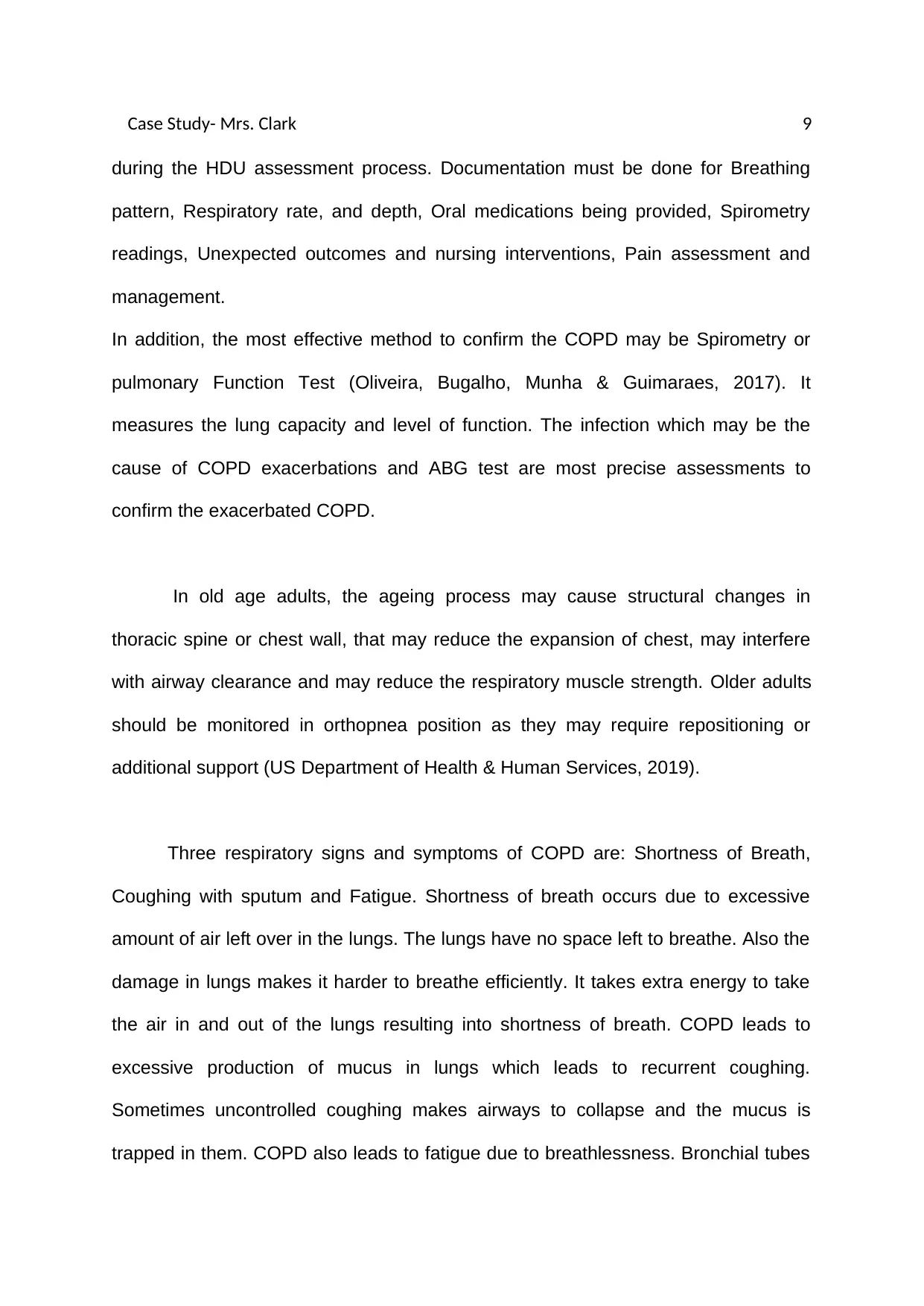
Case Study- Mrs. Clark 9
during the HDU assessment process. Documentation must be done for Breathing
pattern, Respiratory rate, and depth, Oral medications being provided, Spirometry
readings, Unexpected outcomes and nursing interventions, Pain assessment and
management.
In addition, the most effective method to confirm the COPD may be Spirometry or
pulmonary Function Test (Oliveira, Bugalho, Munha & Guimaraes, 2017). It
measures the lung capacity and level of function. The infection which may be the
cause of COPD exacerbations and ABG test are most precise assessments to
confirm the exacerbated COPD.
In old age adults, the ageing process may cause structural changes in
thoracic spine or chest wall, that may reduce the expansion of chest, may interfere
with airway clearance and may reduce the respiratory muscle strength. Older adults
should be monitored in orthopnea position as they may require repositioning or
additional support (US Department of Health & Human Services, 2019).
Three respiratory signs and symptoms of COPD are: Shortness of Breath,
Coughing with sputum and Fatigue. Shortness of breath occurs due to excessive
amount of air left over in the lungs. The lungs have no space left to breathe. Also the
damage in lungs makes it harder to breathe efficiently. It takes extra energy to take
the air in and out of the lungs resulting into shortness of breath. COPD leads to
excessive production of mucus in lungs which leads to recurrent coughing.
Sometimes uncontrolled coughing makes airways to collapse and the mucus is
trapped in them. COPD also leads to fatigue due to breathlessness. Bronchial tubes
during the HDU assessment process. Documentation must be done for Breathing
pattern, Respiratory rate, and depth, Oral medications being provided, Spirometry
readings, Unexpected outcomes and nursing interventions, Pain assessment and
management.
In addition, the most effective method to confirm the COPD may be Spirometry or
pulmonary Function Test (Oliveira, Bugalho, Munha & Guimaraes, 2017). It
measures the lung capacity and level of function. The infection which may be the
cause of COPD exacerbations and ABG test are most precise assessments to
confirm the exacerbated COPD.
In old age adults, the ageing process may cause structural changes in
thoracic spine or chest wall, that may reduce the expansion of chest, may interfere
with airway clearance and may reduce the respiratory muscle strength. Older adults
should be monitored in orthopnea position as they may require repositioning or
additional support (US Department of Health & Human Services, 2019).
Three respiratory signs and symptoms of COPD are: Shortness of Breath,
Coughing with sputum and Fatigue. Shortness of breath occurs due to excessive
amount of air left over in the lungs. The lungs have no space left to breathe. Also the
damage in lungs makes it harder to breathe efficiently. It takes extra energy to take
the air in and out of the lungs resulting into shortness of breath. COPD leads to
excessive production of mucus in lungs which leads to recurrent coughing.
Sometimes uncontrolled coughing makes airways to collapse and the mucus is
trapped in them. COPD also leads to fatigue due to breathlessness. Bronchial tubes
⊘ This is a preview!⊘
Do you want full access?
Subscribe today to unlock all pages.

Trusted by 1+ million students worldwide

Case Study- Mrs. Clark 10
get inflamed and narrowed. Emphysema causes lung damage, through alveoli
destruction (Anzueto & Miravitlles, 2017) . The body uses additional strength to fully
vacate the lungs, hence it may lead to increase in body fatigue.
.
get inflamed and narrowed. Emphysema causes lung damage, through alveoli
destruction (Anzueto & Miravitlles, 2017) . The body uses additional strength to fully
vacate the lungs, hence it may lead to increase in body fatigue.
.
Paraphrase This Document
Need a fresh take? Get an instant paraphrase of this document with our AI Paraphraser

Case Study- Mrs. Clark 11
References:
Anzueto,A., & Miravitlles,M., (2017). Pathophysiology of dyspnea in COPD.
Postgrad Med. 2017 Apr; 129(3):366-374. doi:
10.1080/00325481.2017.1301190
Berg, K. & Joanne L. W. (2016). The Pathology of Chronic Obstructive Pulmonary
Disease: Progress in the 20th and 21st Centuries. Archives of Pathology
& Laboratory Medicine: December 2016, 140(12),1423-1428.
Chiale, P. A., Etcheverry, D., Pastori, J. D., Fernandez, P. A., Garro, H. A.,
González, M. D., & Elizari, M. V. (2014). The multiple
electrocardiographic manifestations of ventricular repolarization
memory. Current cardiology reviews, 10(3), 190–201.
https://doi.org/10.2174/1573403x10666140514102021
Dukkipati,S.R., Choudry,S., Koruth,J.S., & Miller,M.A.(2017). Catheter Ablation of
Ventricular Tachycardia in Structurally Normal Hearts. Journal of the
American College of Cardiology. 70 (23), December 2017.
DOI: 10.1016/j.jacc.2017.10.031
Foth C, Gangwani MK, & Alvey H.(2020). Ventricular Tachycardia (VT, V Tach).
Treasure Island (FL): StatPearls Publishing. Retrieved from:
https://www.ncbi.nlm.nih.gov/books/NBK532954/
References:
Anzueto,A., & Miravitlles,M., (2017). Pathophysiology of dyspnea in COPD.
Postgrad Med. 2017 Apr; 129(3):366-374. doi:
10.1080/00325481.2017.1301190
Berg, K. & Joanne L. W. (2016). The Pathology of Chronic Obstructive Pulmonary
Disease: Progress in the 20th and 21st Centuries. Archives of Pathology
& Laboratory Medicine: December 2016, 140(12),1423-1428.
Chiale, P. A., Etcheverry, D., Pastori, J. D., Fernandez, P. A., Garro, H. A.,
González, M. D., & Elizari, M. V. (2014). The multiple
electrocardiographic manifestations of ventricular repolarization
memory. Current cardiology reviews, 10(3), 190–201.
https://doi.org/10.2174/1573403x10666140514102021
Dukkipati,S.R., Choudry,S., Koruth,J.S., & Miller,M.A.(2017). Catheter Ablation of
Ventricular Tachycardia in Structurally Normal Hearts. Journal of the
American College of Cardiology. 70 (23), December 2017.
DOI: 10.1016/j.jacc.2017.10.031
Foth C, Gangwani MK, & Alvey H.(2020). Ventricular Tachycardia (VT, V Tach).
Treasure Island (FL): StatPearls Publishing. Retrieved from:
https://www.ncbi.nlm.nih.gov/books/NBK532954/
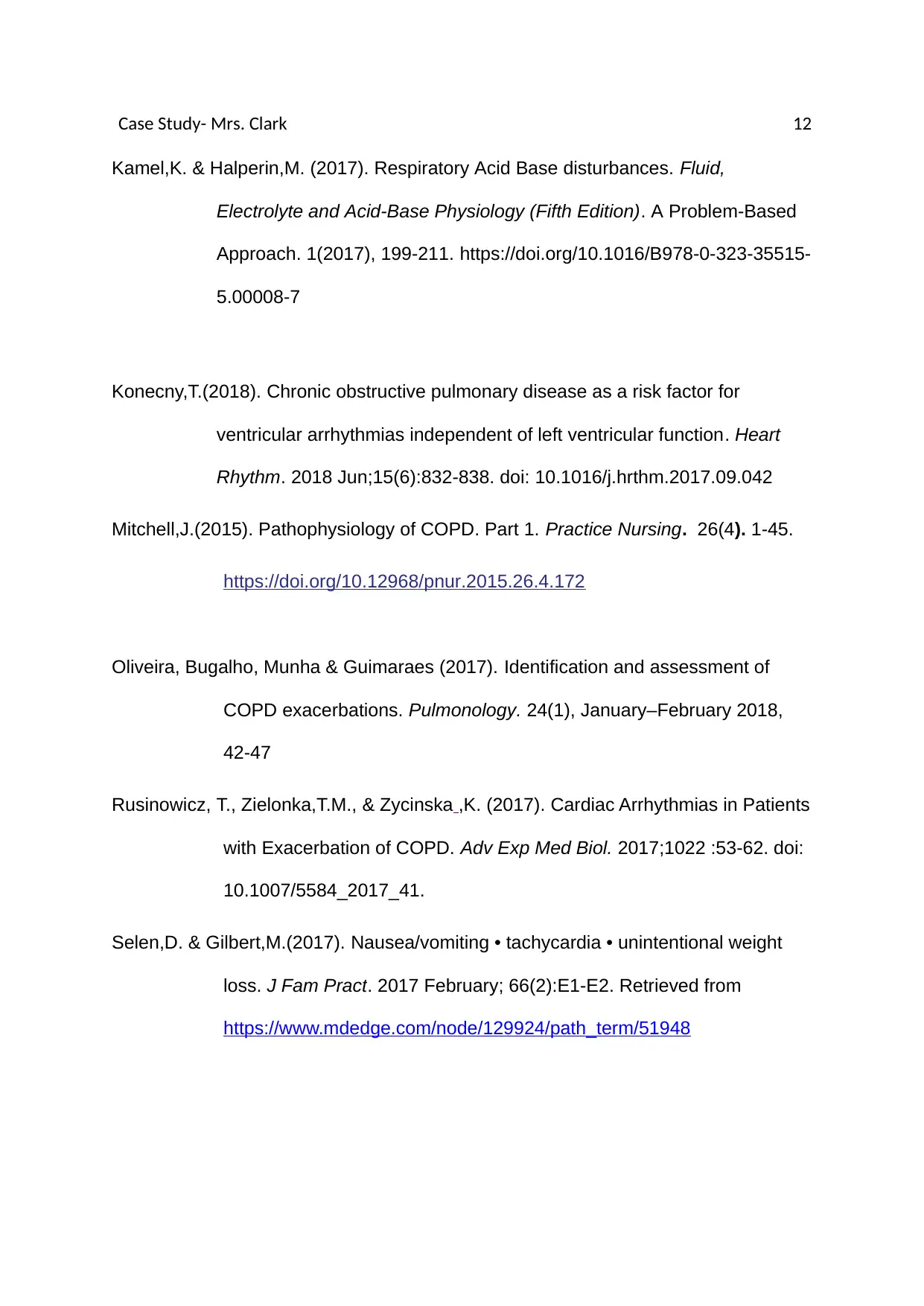
Case Study- Mrs. Clark 12
Kamel,K. & Halperin,M. (2017). Respiratory Acid Base disturbances. Fluid,
Electrolyte and Acid-Base Physiology (Fifth Edition). A Problem-Based
Approach. 1(2017), 199-211. https://doi.org/10.1016/B978-0-323-35515-
5.00008-7
Konecny,T.(2018). Chronic obstructive pulmonary disease as a risk factor for
ventricular arrhythmias independent of left ventricular function. Heart
Rhythm. 2018 Jun;15(6):832-838. doi: 10.1016/j.hrthm.2017.09.042
Mitchell,J.(2015). Pathophysiology of COPD. Part 1. Practice Nursing. 26(4). 1-45.
https://doi.org/10.12968/pnur.2015.26.4.172
Oliveira, Bugalho, Munha & Guimaraes (2017). Identification and assessment of
COPD exacerbations. Pulmonology. 24(1), January–February 2018,
42-47
Rusinowicz, T., Zielonka,T.M., & Zycinska ,K. (2017). Cardiac Arrhythmias in Patients
with Exacerbation of COPD. Adv Exp Med Biol. 2017;1022 :53-62. doi:
10.1007/5584_2017_41.
Selen,D. & Gilbert,M.(2017). Nausea/vomiting • tachycardia • unintentional weight
loss. J Fam Pract. 2017 February; 66(2):E1-E2. Retrieved from
https://www.mdedge.com/node/129924/path_term/51948
Kamel,K. & Halperin,M. (2017). Respiratory Acid Base disturbances. Fluid,
Electrolyte and Acid-Base Physiology (Fifth Edition). A Problem-Based
Approach. 1(2017), 199-211. https://doi.org/10.1016/B978-0-323-35515-
5.00008-7
Konecny,T.(2018). Chronic obstructive pulmonary disease as a risk factor for
ventricular arrhythmias independent of left ventricular function. Heart
Rhythm. 2018 Jun;15(6):832-838. doi: 10.1016/j.hrthm.2017.09.042
Mitchell,J.(2015). Pathophysiology of COPD. Part 1. Practice Nursing. 26(4). 1-45.
https://doi.org/10.12968/pnur.2015.26.4.172
Oliveira, Bugalho, Munha & Guimaraes (2017). Identification and assessment of
COPD exacerbations. Pulmonology. 24(1), January–February 2018,
42-47
Rusinowicz, T., Zielonka,T.M., & Zycinska ,K. (2017). Cardiac Arrhythmias in Patients
with Exacerbation of COPD. Adv Exp Med Biol. 2017;1022 :53-62. doi:
10.1007/5584_2017_41.
Selen,D. & Gilbert,M.(2017). Nausea/vomiting • tachycardia • unintentional weight
loss. J Fam Pract. 2017 February; 66(2):E1-E2. Retrieved from
https://www.mdedge.com/node/129924/path_term/51948
⊘ This is a preview!⊘
Do you want full access?
Subscribe today to unlock all pages.

Trusted by 1+ million students worldwide
1 out of 13
Related Documents
Your All-in-One AI-Powered Toolkit for Academic Success.
+13062052269
info@desklib.com
Available 24*7 on WhatsApp / Email
![[object Object]](/_next/static/media/star-bottom.7253800d.svg)
Unlock your academic potential
Copyright © 2020–2025 A2Z Services. All Rights Reserved. Developed and managed by ZUCOL.



